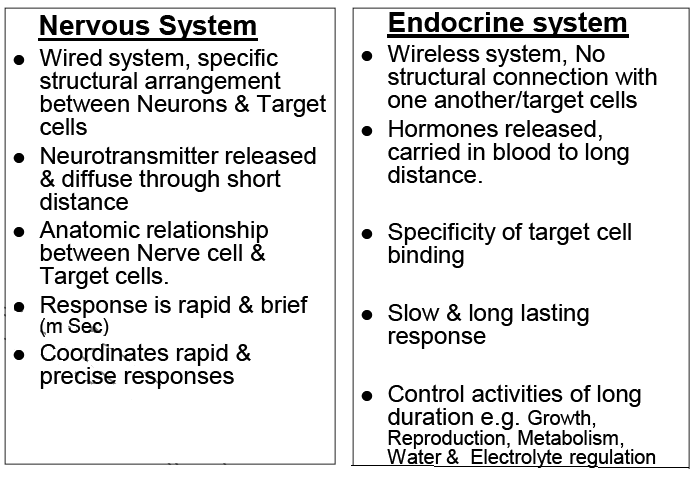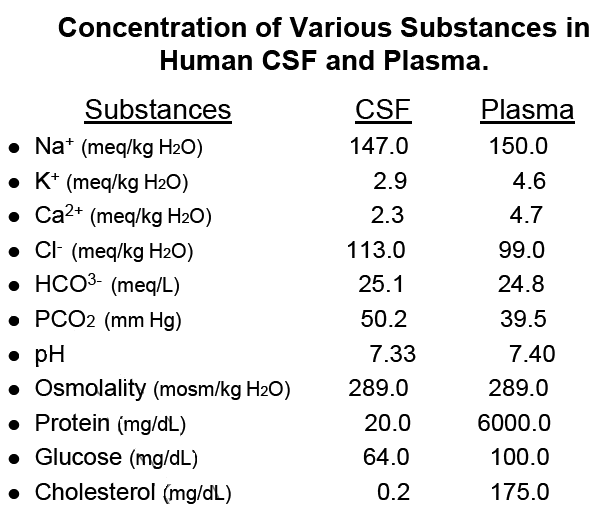Nervous System
Two control systems of the body:
1. Nervous system: “System of wires”
Coordinates rapid & precise responses
2. Endocrine system: “Wireless system” through blood
Regulates activities that rerequire duration rather than speed.
Despite separate areas of specialization, both systems are interconnected functionally;
e.g. Neurohormones
Release of hormones by Nerve Signals
Hormones ——as neuro modulators
Sometimes Nerve signals & Hormones act on the same target cells e.g. GIT, Bl. vessels, Heart etc.
Organization of Nervous System
The Nervous system comprises of:
CNS — Brain & Spinal cord
PNS — Nerve fibers that carry information between CNS & Other parts of the body
Three classes of Neurons :- “Functional”
1. Afferent: Apprise CNS about Ext & Int Environment (Receptors)
2. Efferent: Carry instructions from CNS to effectors
3. Interneuron: Integrate Afferent information, to formulate efferent
response. Approx; 100 billion in human CNS i.e. 99% of all Neurons.
Peripheral Nervous System (PNS)
PNS has two divisions;
1. Afferent Division (Sensory)
2. Efferent Division (Motor)
a. Somatic Nervous system (Voluntary):
Cell bodies within ventral horn of Spinal cord
Fibers of motor neurons to Sk. Muscles
Release Acetyl choline
Excitatory in action
Inhibition within CNS (Through activation of inhibitory synaptic input)
b. Autonomic Nervous system (Involuntary):
Innervate Smooth & Cardiac muscles and Glands
(1) Sympathetic
(2) Parasympathetic
Motor Part of Nervous System:
1. Somatic
2. ANS
Effectors:
a. Muscles
b. Glands
Eventual role of nervous system is to control various bodily activities
i.e.
1. Contraction of Sk muscles
2. Contraction of smooth muscles
3. Secretion of chemicals by exocrine & endocrine glands
Sk. Muscles can be controlled by;
1. Spinal Cord
2. Reticular subs of Medulla, Pons & Mesencephalon
3. Basal Ganglia
4. Cerebellum
5. Motor cortex
Major Levels of CNS Function
Three Major Levels:-
A. Spinal Cord Level:
1. Conduit for signal from periphery
2. Centers/Neuronal circuits for;
a. Walking movements.
b. Withdrawal reflex
c. Support against gravity
d. Control of local blood vessels,
GIT, Urinary excretion
B. Sub cortical or Lower Brain Level:
Medulla, Pons, Mesencephalon, Thalamus, Hypothalamus, Cerebellum, Basal ganglia.
Control subconscious activities of the body
a. Arterial pressure
b. Respiration
c. Equilibrium
d. Feeding reflexes (Salivation, licking of lips)
e. Emotional responses (Anger, Excitement, Sexual response, Response to pain, Pleasure etc)
C. Cortical or Higher Brain level
Cerebral cortex is the largest memory store house.
Cortex never functions alone, always with lower centers
Essential for most thought processes, but not alone
Lower brain centers initiate wakefulness in cortex to open bank of memories of brain
Upper levels of nervous system operate by sending signals to control centers of “cord” i.e. “commanding” the cord centers to perform their functions
The Neuron
Anatomic & Functional unit of nervous system
Neuron consists of :
Cell body (Soma) & Processes (Dendrites & Axons i.e. Nerve fibers)
Myelinated fibers:
Unmyelinated Fibers:
Properties of a Nerve Fiber
Excitability
Conductivity
All or None law
Refractory period
Summation
Accommodation / Adaptation
Indefatigability
Compound Action Potential
Monophasic AP
Biphasic AP
Protection of Brain
Brain is protected by:
i. 3 layers of Meninges (Wrap the brain)
ii. Hard bony cage outside
iii. CSF inside & outside (Cushion against jarring)
iv. Chemical protection by Bl. Br. Barrier
Nourishment of Brain:
O2 & Glucose
Through Blood supply
Supporting Cells
90% of cells in CNS (10-50 times the no. of neurons)
Occupy ½ Vol. of brain
Physical & Metabolic support to neurons
Do not branch as neurons do
Do not initiate or conduct nerve impulses
Help in growth & nourishment of Neurons
Serve as CT of CNS, derived from ectoderm
Homeostatically maintain composition of ECF of Neurons
Actively modulate synaptic function
Two types of supporting cells in PNS:
i. Schwann cells: form myelin sheath around peripheral
nerves
ii. Satellite cells or ganglionic gliocytes: support cell bodies in ganglia of PNS
Four types of supporting cells in CNS:
[Glial Cells: Neuroglia (Gk; glia = glue)]
1. Astrocytes:
1. Most abundant, occupy mainly white matter.
2. Physically support neurons in proper spatial relationship
3. Send processes to:
(a) cover nerve cells & synapses.
(b) blood vessels (capillaries), forming
tight junctions to form BBB
4. Form neural scar tissue
5. Take up & degrade neurotransmitter (e.g. Glutamates, GABA)
6. Take up excess K+ to maintain ECF conc. /Neural excitability
7. Enhance synapse formation/Synaptic transmissionii. 2. Oligodendrocytes: Myelination of CNS neurons
3. Microglia: Immune defense cells/ Macrophages of CNS
4. Ependymal cells: * Line internal cavities of CNS
* Formation of CSF
* Neural stem cell, have potential to form other
glial cells & neurons ? e.g. Hippocampus (Memory &
learning)
Blood Brain Barrier
The endothelial cells of brain capillaries are joined by tight junctions that prevent materials for passing between the cells.
The only passage across brain capillaries is through endothelial cells by diffusion, active transport, endocytosis pinocytosis [selective bloodbrain
barrier].
Difficulty in chemotherapy of brain
Cerebrospinal Fluid (CSF)
Shock absorbing fluid [Surround & cushion the brain & spinal cord]
Same density as brain
Formed by choroid plexuses (in ventricles) By selective transport processes
Volume = 150 ml
Formation = 550 ml/day [3.7 times turn over/day]
Composition of CSF & brain interstitial fluid is same
CSF pressure = 10 mmHg
Excess accumulation of CSF [Hydrocephalus; water on the
brain] → brain damage, mental retardation
 howMed Know Yourself
howMed Know Yourself


